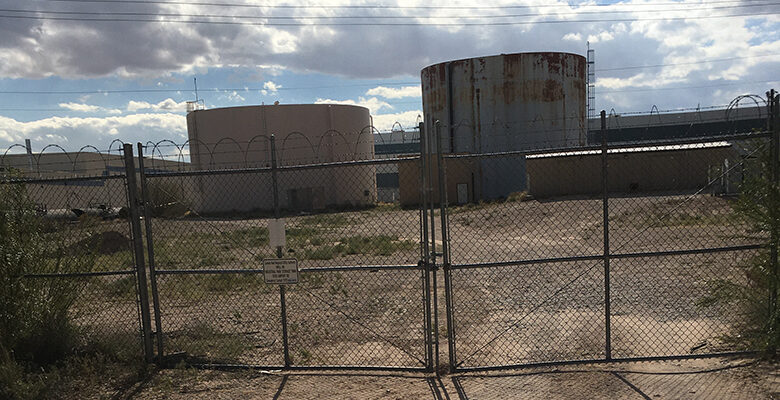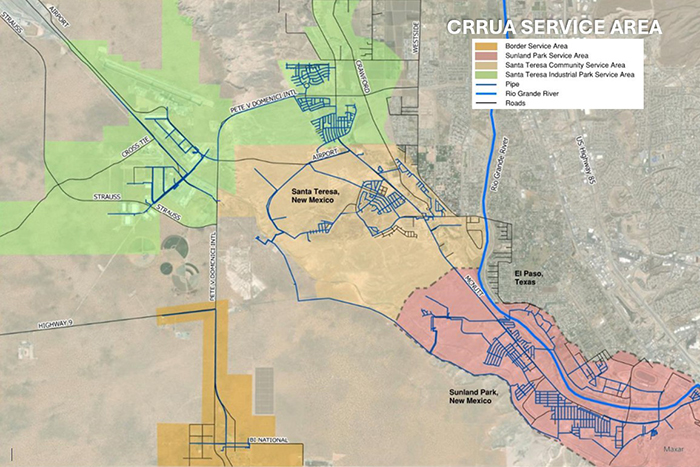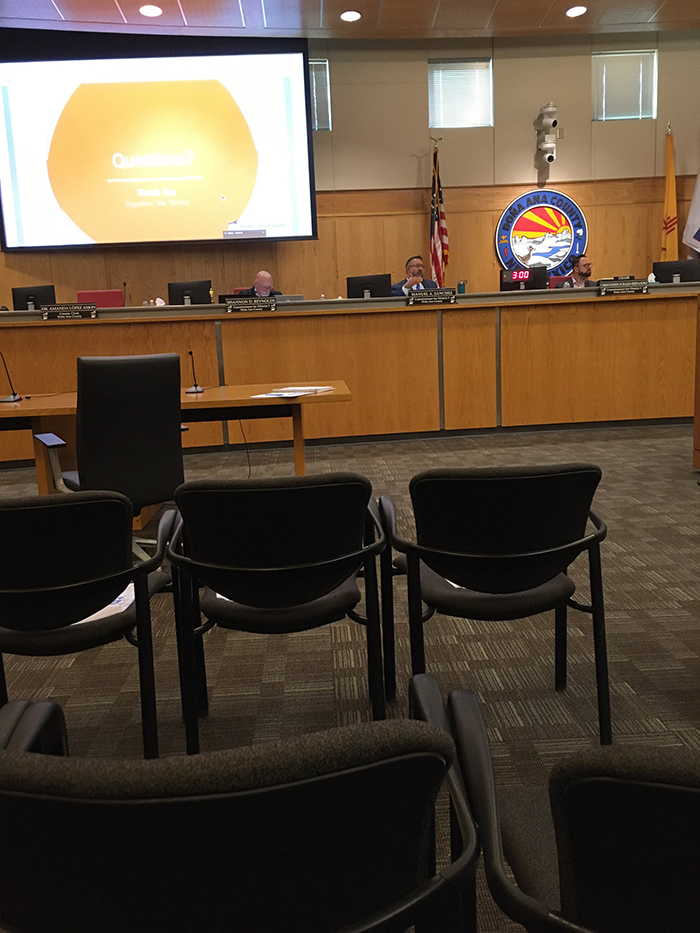By Kent Paterson
Customers of the Camino Real Regional Utility Authority (CRRUA) in the New Mexico border communities of Sunland Park and Santa Teresa will likely pay significantly more for water and wastewater services during the next four years.
A proposed rate hike was approved at the November 10 CRRUA Board of Directors meeting as well as at the November 14 session of the Doña Ana County Board of County Commissioners.
Both entities gave their respective nods to higher service costs based in part on a detailed study prepared by the California-based Jacobs Engineering Group consultants which examined the current and near-term costs and expenses for operating CRRUA, a water utility serving 20,000 plus residents, institutions and businesses in a service area where water demands are only growing.
According to an informational sheet posted on the CRRUA website, higher service costs are necessary considering that CRRUA has only raised rates once in the last 20 years, in July 2024.
“Expenses went up while rates stayed the same,” CRRUA states. “This resulted in the utility lacking sufficient funds for adequate staffing, equipment maintenance, and timely repairs.”
Customers will feel the biggest pinch next year when an average monthly bill for both water and wastewater service is expected to cost an extra $19.64, according to CRRUA’s estimate. From 2027 to 2030, combined water-wastewater rates will annually increase an estimated 6 percent, per the planned rate hike.
Individual water and wastewater bills, of course, can vary widely from customer to customer depending on usage.
A CRRUA chart shows that its bills are currently lower than in the southern New Mexico communities of Hatch, Anthony and Alamogordo but more expensive than in Las Cruces and Deming.
The proposed CRRUA rate hike and Jacobs Engineering study was publicly presented at a CRRUA-sponsored workshop in Sunland Park on October 14. A final vote on the rate hike must be taken by the Sunland Park City Council, which canceled its regular meeting November 18 but is scheduled to convene again at 6 pm on December 3.
A notice of intent to adopt an ordinance approving the rate hike at the December 3 meeting is posted on the city government’s website.
Three times since October 22, the reporter has emailed City of Sunland Park Communications Coordinator Yasmine Al-Harbi asking if a low-income fund is under consideration by the city government to assist financially stressed residents with higher water bills and whether alternative sources of funding are available for capital improvements, but still has not received a response.
In a December 2024 letter to the U.S. Environmental Protection Agency on behalf of Sunland Park and Santa Teresa community members, the New Mexico Environmental Law Center requested a safe drinking water inspection of CRRUA and other actions, stating that the Sunland Park and Santa Teresa region ranked in the “highest percentiles” of the federal agency’s Environmental Justice Screen, with people of color making up 92 percent of the population and 91 percent identifying as Hispanic. More than half of the population (52 percent) fell into the low-income category, with a per capita income of $25,763, according to the Environmental Law Center.
Yet no member of the public addressed the rate hike at the November 14 County Commission meeting. The meeting was among the more sparsely attended ones in recent months, when controversies such as the Project Jupiter/Stargate AI data center under construction in Santa Teresa generated robust public turnout and commentary. On November 14, County staff had reserved an entire row of seats for the media, but yours truly was the only reporter present.
El Pasoans, meanwhile, likewise face higher water bills in 2026. El Paso media outlets report that El Paso Water plans to hike the average monthly water bill by $9.99 (not an even 10 bucks) in order to help pay for needed infrastructure investments.
According to the Public Service Board (PSB) website, public comment on the rate hike is welcome at the December 10 and January 14 PSB meetings.
Prior to the meetings, El Paso Water will host an Open House on Dec. 2 from 5-7 p.m. at the TecH2O Center, 10751 Montana Ave., where information will be available about the proposed budget and utility plans for Fiscal Year 26-27. The PSB notes that “written comments will be accepted and shared with the PSB Communications Committee.”
(For presentations, videos and other details, visit https://www.epwater.org/ep-water/uploads/proposed-budget-fy-2026-27-11-14-2025-www.pdf).
A vote on the proposed increase is expected at the January 14 meeting. If the PSB Board approves, the higher water service rate will take effect March 1, 2026.
The Doña Ana County Commission Votes Yes
Utterances of regret and instances of hand wringing rippled through the Doña Ana County Commission as it unanimously voted 5-0 to approve the CRRUA rate hike. The vote was taken after Assistant County Manager Stephen Lopez warned the elected officials that CRRUA could go broke by next April if rates (and overall revenue) don’t go up. What’s more, CRRUA lacks financial reserves to tackle a “large system failure,” and can’t get bond financing because of the absence of a revenue stream.
Insisting that he did not “absolutely agree with a huge rate increase,” Commissioner Manuel Sanchez nevertheless added that “I do not think we have another option.”
According to CRRUA, new money is sorely needed to hire and retain qualified water and wastewater operators, perform maintenance and emergency repairs, replace aging infrastructure, pay for new state and federal loan projects, and reserve “funds for future upgrades, “instead of waiting for breakdowns.” The utility estimates the value of its infrastructure at $81.5 million, including “aging assets needing maintenance to fulfill today’s and tomorrow’s demands.”
The Jacobs Engineering study estimated that necessary infrastructure improvements to the utility would cost $90.7 million between 2026 and 2030.
Weighing in remotely, County Commission Vice-Chair Susana Chaparro backed a rate hike, arguing too that CRRUA was running out of money. “Nobody wants this increase at this time. Could it have been done at a slower rate? Probably, I can’t guess on that at this point,” Chaparro said. “I don’t think any of us enjoy voting on this option, but I see no other way.”
In a reflection on the history of CRRUA, Chaparro lamented the hiring away of qualified water operators by other cities, organizational flaws in the establishment of the utility, and a frequent turnover of commissioners with CRRUA responsibilities.
Chaparro reminded the meeting that she and the rest of the current commissioners, except Chair Christopher Schlajo-Hernandez, had been CRRUA board members at one time or another. Currently, Commissioner Gloria Gameros sits on the CRRUA board.
During the last five years, at least 19 different individuals, county commissioners and others, have held the seven CRRUA board seats.
Taking the long view, serious concerns over qualified water operator shortages, revenue shortfalls, infrastructure conditions, the CRRUA Board of Directors and more were all sketched out in an independent report on CRRUA’s operations by the UNM-based Southwest Environmental Finance Center dated March 10, 2016 and sent to CRRUA. Then CRRUA Executive Director Brent Westmoreland reviewed the report, responding to the Center’s observations with mixed responses.
Almost ten years later, nagging questions linger: If many of CRRUA’s current troubles were identified long ago, where was the oversight, funding and enforcement accountability during the past decade?
Developers, Donut Holes and a Delayed Divorce
Jointly overseen by the Doña Ana County government and the City of Sunland Park, both of which contribute members to the CRRUA Board of Directors, CRRUA is currently immersed in a thorny division between the county and city governments, with the former saying it’s hamstrung in assessing the condition of the utility’s assets and the latter already forging ahead with a new municipal utility department.
Under their existing Joint Powers Agreement, Doña Ana County and the City of Sunland Park have less than four years to conclude the CRRUA division, though officials from both governments have expressed their desires to this reporter to wrap up the divorce much, much sooner.
Last May, shortly after Doña Ana County announced that it was pulling out of the Joint Powers Agreement, Stephen Lopez told the reporter that the county government had hired HDR Engineering to conduct a comprehensive study of the condition of CRRUA’s assets.
(https://elchuqueno.com/the-sunland-park-santa-teresa-chronicles-cannabis-crrua-and-capitalism/)
Six months later HDR’s assessment is still waiting to happen, delayed by the uncertainty of post CRRUA break-up jurisdictions. According to Lopez, the reason is because of land annexations pursued by the City of Sunland Park.
“We felt we had arrived at a reasonable determination of (future) service areas over the summer but since then the City of Sunland Park has had one annexation and they’ve proposed another very large one of over 2,600 acres that’s being considered right now,” Lopez told this reporter.
“And that changes potentially the service areas and we can’t invest in new infrastructure if we don’t know if it’s gonna be on the county side or it might be in the City of Sunland Park side, so the county has reached out to the City of Sunland Park and asked for a firm commitment between both the (Sunland Park) City Council and the County Commission to agree on what service areas will be so we can move forward…”
During the November 14 County Commission meeting, Lopez and Commissioner Sanchez commented that within the broad annexation zone sought by Sunland Park stand populated clusters or “donut holes” excluded from the annexation petition map, thus creating possible confusion between county and municipal entities over who will be responsible for services and emergencies.
Consisting of 2,625.5 acres, the proposed annexation is located along the western municipal boundary of Sunland Park and Country Club Road. Developers including the Collins Group of El Paso plan mixed use commercial and residential properties for the petitioned annexation, a portion of which will be named Santa Teresa Estates.
Reportedly, however, some current residents living close to the proposed annexation zone are unhappy with Sunland Park’s plan and could be seeking legal action. Nearly two hours into the November 14 County Commission meeting, the elected officials went into a closed executive session to discuss “threatened or pending litigation” related to the annexation petition.
Reconvening after slightly more than one half hour, the County Commission resumed an earlier discussion in the day about sending a letter to the City of Sunland Park before unanimously approving a resolution sponsored by Commissioner Reynolds to postpone action on the annexation issue until the November 25 County Commission meeting, pending more information from the City of Sunland Park.
For its part, the Sunland Park City Council is anticipated to vote on the water service rate hike, as well as the big annexation proposal and two zoning change ordinances, at its scheduled December 3 meeting. Depending on the outcome, the meeting could significantly shape the futures south Doña Ana County residents for years to come.




Quick Update:
Tensions between Doña Ana County Commission and the City of Sunland Park over the CRRUA break-up and Sunland Park’s latest annexation petition for 2,625.5 acres escalated at the November 25 County Commission meeting in Las Cruces. All five commissioners voted to oppose the annexation and authorized the county government’s legal team to take any necessary actions to stop it.
Commission Chair Christopher Schaljo-Hernandez framed his position in the context of the still unresolved CRRUA break-up, expressing concerns that Sunland Park’s focus on land annexations was diverting attention away from the water quality issue and post-CRRUA services.
“I really just want to make sure that we are putting the attention back on the issue at hand, which is safe and clean drinking water and making sure that CRRUA is coming to a close,” Schaljo-Hernandez said.
Commissioner Shannon Reynolds, a former member of the CRRUA Board of Directors, contended that the City of Sunland Park was “dragging their feet” in the CRRUA dissolution process, which began last spring, “and actually putting more of the citizens at risk of not getting clean water soon enough…”
After Reynolds explained the Commission’s vote to members of the public in attendance, Schaljo-Hernandez added, “There you go, putting an end to the nonsense.” The controversial annexation is scheduled to be considered by the Sunland Park City Council on December 3. Stay tuned.
Kent Paterson
Cynthia Gomez of Voces Feministas and RAICES of KUNM Public Radio here. Thank you Kent for your investigation and reporting, not only this story but the many you have done over the years. As a producer of Voces Feministas I am attempting to develop and propose a New Mexico Public Affairs Program, “Situation NM in Brief” (working title), into Voces Feministas live programming as part our Radio Magazine, where reports like yours can be topically referenced then listeners provided with a link to read up in their leisure. I think we can also add the link in our FB page for easier reference. I’m attempting to develop a 5 minute “brief” to provide a synopsis or “tease” of stories that journalistically report on community issues that are not often enough heard on KUNM. As you may know, public affairs programming by people of color has become contentious in the last couple years more recently since we were walked-back by management on a Palestinian Student Interview by Luna, at the time a Raices member. More recently, KUNM public affairs programming was halted to face a severe editing procedure to develop pre-recorded, pre-approved public affairs program for Voces, Raices and possibly Singing Wire. The time requirement is prohibitive for 95% of public affairs programmers who work full time, have families and a deep community service outside KUNM. So as an alternative, we’ve been running pre-aird programs for Espejos and not producing other critical programming. I have been told by management we are the only groups producing public affairs who are expected to take the the upcoming public affairs training scheduled for December. The other part of our situation is that proposed program changes are deemed necessary to fit in more local news for our listeners. Both Voces and Raices have independently written letters to Tristan with objections to changes proposed for our programs, as well as the justification of moving other local programming out of their established well listened to time slots, while speaking to the local value and importance of national latino, LGBTQ+, women’s, and social justice programming, not to mention the ghetoizing of latino programming. Voces was especially hit hard with the split While Raices was asked to move forward an hour, Voces, a 2-hour monthly Saturday program was asked to be sliced and squeezed from a two-hour radio magazine, to two one-hour split. For women producers, this is time prohibitive, and an attack on the cohesive work a women of color, collaborative on raising the voices of marginalized communities and voices. So, my thought is to take news stories from news outlets to inform folks of these important and timely situations that communities are facing. As a state we have a commitment to each other in our support and response to need, struggle and unity. Why is a Southern NM story important to Central and Northern NM communities and vise versa? Because we are New Mexico. If one can’t understand this, there is a lack of history, struggle and redemption. We matter to each other. The survival of one community is depedant on the other, while the circumstances may change, it remains a historical fact. It also holds all representatives accountable to the larger community of people and not obligated to institutional politics or privileges. So in the spirit of information access, democratic engagement and accountability I would like to add this one monthly New Mexico Briefs as a public affairs segment that leads listeners to access, read and take part in an informed democratic process. This is one such story that I believe we can and should follow up on. I’m working on framing and delivering this to Voces Collective and will follow up with Raices/Espejos. I’ve notices that KUNM news is referencing the Source as a source of news in recent weeks. I don’t see why we can’t reference any news source with a relevant New Mexican story. Hope to keep this conversation moving along. Best, Cynthia Gomez